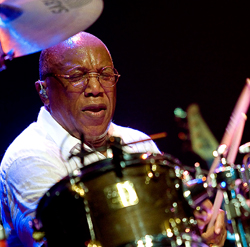
Without the benefit of binaural summation using both ears and a stereo mix, a single IEM will need to be up to 10 dB louder, which can gradually cause as much hearing damage as not using IEMs. A vicious cycle ensues, with louder stages and louder IEMs.
We know from our permissible exposure limit (PEL) SPL/time exchange rate that for every additional 5 dB of SPL (or 3 dB), exposure time is halved, so single IEM performers can experience temporary threshold shift in half the time or less compared to a performer using both IEMs. A 2-hour set that was safe using both IEMs can begin injuring ears in 60 minutes when only one ear is used.
Not Automatic
When switching to in-ear monitors, most musicians that are used to floor monitors often match the volume on their packs to previous wedge levels, providing little or no benefit for hearing protection.
A 2008 study at Vanderbilt by Federman and Ricketts titled Preferred and Minimum Listening Levels for Musicians While Using Floor and In-Ear Monitors discovered that musicians moving from wedges to IEMs monitored less than a dB lower when allowed to set their own levels.
However, their Minimum Acceptable Listening Level using floor monitors was less than 2 dB lower than their Preferred Listening Levels, while for in-ear monitors their minimum was 6 dB lower than their preferred, meaning there’s a better chance to turn it down with IEMs. And a 6 dB reduction allows 4 times longer safe exposure.
Although there’s a negligible difference in Preferred Listening Levels between floor and in-ear monitors, the latter reduces exposure by just enough to conserve hearing if there’s a conscious effort by performers and their engineers.
Focused Mix
What kind of mix promotes safe monitoring? A “focused” mix that helps performers by concentrating on essentials, instead of a full studio headphone mix. What are the in-ear monitor “mix essentials” for a musical performer on stage?
Musicians discover that instead of a full-on studio control room mix, a focused mix helps them concentrate on their performance and also allows them to monitor at lower levels. It also centers the musician’s own sounds in their mix, with elements from other musicians that require interaction panned to one side at lower levels, adding only a minimum of sources needed for intonation or timing, such as piano or keyboards, hi-hat, bass and maybe kick drum.
Monitoring the hi-hat channel without using the snare mic can result in mixes being quieter, since plenty of snare gets into the hi-hat mic for most performers – except drummers. Some IEM performers just want drum overheads, to monitor a gentler drum sound. Others learn they need little or no kick drum. The key is to only monitor instruments you play, or get time or intonation from.
Panning Is Your Friend
Our brains are used to hearing in stereo. Many sources can be placed more naturally in stereo. Panned vocals are easier to harmonize with. In addition, panning allows other performers’ inputs to be lower in level, providing a quieter mix. Some drummers don’t like their toms panned because they turn their heads as they play around their toms.
Wireless IEM systems use “FM Multiplex” or MPX to transmit stereo over mono, and its stereo separation is reduced: sources hard-panned to 7 o’clock or 5 o’clock actually sound like 9 o’clock and 3 o’clock.
Wireless IEMs also have little response above 15 kHz. Hard-wired IEMs have higher fidelity and sound better than analog wireless, which is why drummers prefer them.
What’s Your Number?
Wireless IEM packs combined with typical IEMs produce enough SPL to injure hearing if used long enough: 100 dB at 1 inch (ear canal) is similar to 136 dB at 64 inches (floor monitor). Be aware of the pack’s volume control number. Notice changes during each show and over time.
Mark Frink is a veteran monitor engineer who’s currently working with the Jacksonville Symphony and is available to tour in 2016. Micheal Santucci, Au.D. is a doctor of audiology as well as the founder and president of Sensaphonics Hearing Conservation in Chicago.


